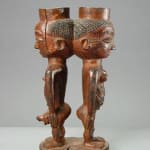Kuba Double Figural Palm Wine Cup, 20th Century CE
Wood
9.5
PF.6110
Further images
Palm wine, obtained from the raffia palm tree, is the most popular beverage consumed in the areas inhabited by the Kuba tribe. Today, plastic cups or glasses are used for...
Palm wine, obtained from the raffia palm tree, is the most popular beverage consumed in the areas inhabited by the Kuba tribe. Today, plastic cups or glasses are used for drinking it; however, during the 19th and early 20th centuries, decorated wooden cups were carved by several tribes across the Southern Savanna. The Kuba specifically are known for their figural and cephalomorphic (head-shaped) cups. This vessel is a perfect example of the masterful artistry of the Kuba woodcarvers. The most striking feature is the unusual composition depicting a man and woman standing back to back. Their heads are conjoined from behind and both, together, serve as the vessel. If one looks inside the interior of the cups, one will find a small hole that allows the wine to flow evenly between the two cups. Although the figures’ heads are grossly disproportionate to their bodies, they are carved in a fairly naturalistic style. Both stand erect with their hands held to their sides (although the male grasps his penis with one of his hands). The man is noted for his distinctive coiffure, a virtual signature of Kuba art. The woman stands out for her carefully rendered keloid scarification that covers her stomach, considered both a beauty mark and a symbol of prestige. A cup such as this was certainly originally carved as a prestigious display piece for titled individuals of the Kuba tribe. Surely the vessel’s inherent beauty and functional durability rival or surpass that of any fine crystal stemware or bejeweled chalice.





